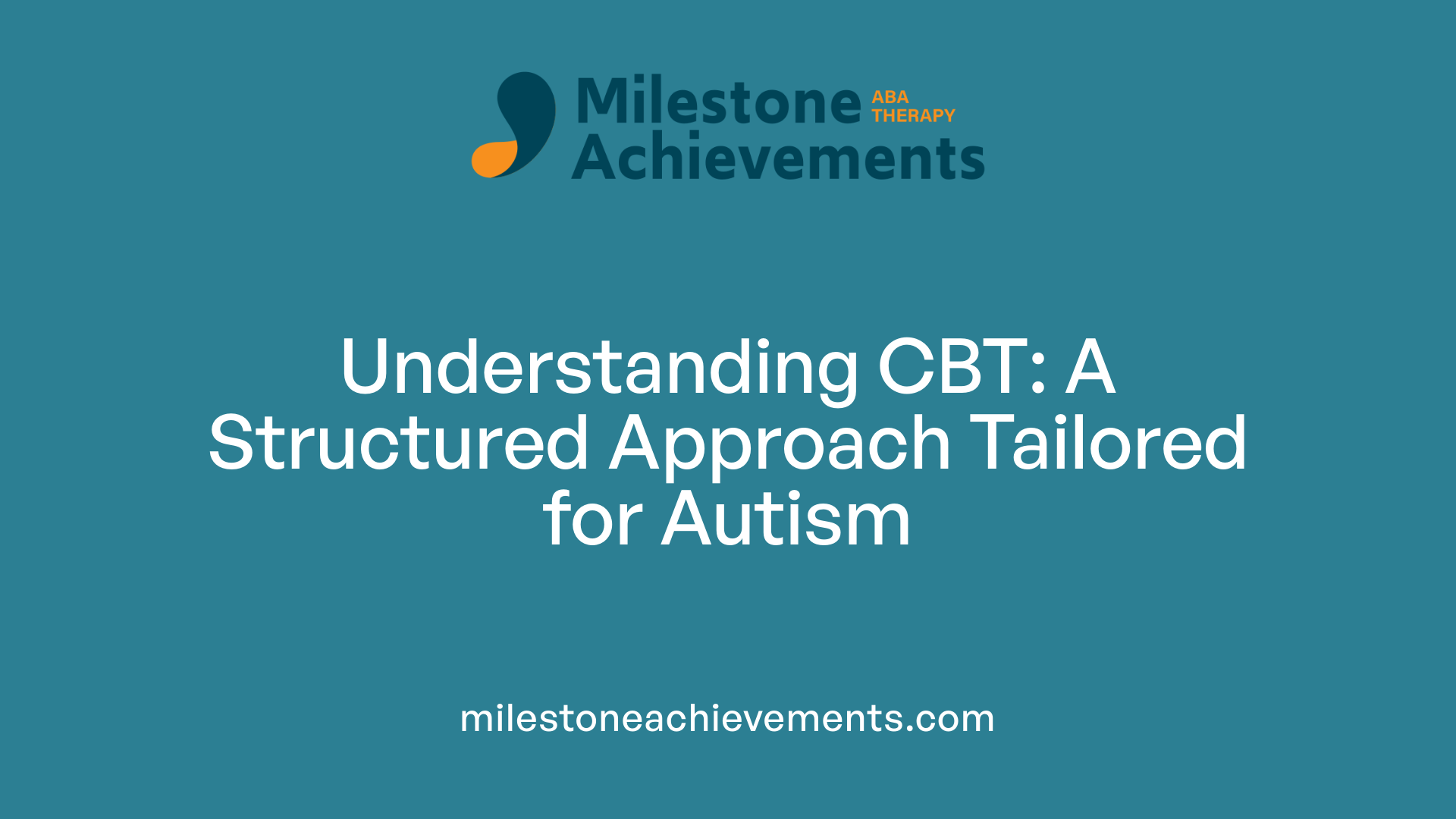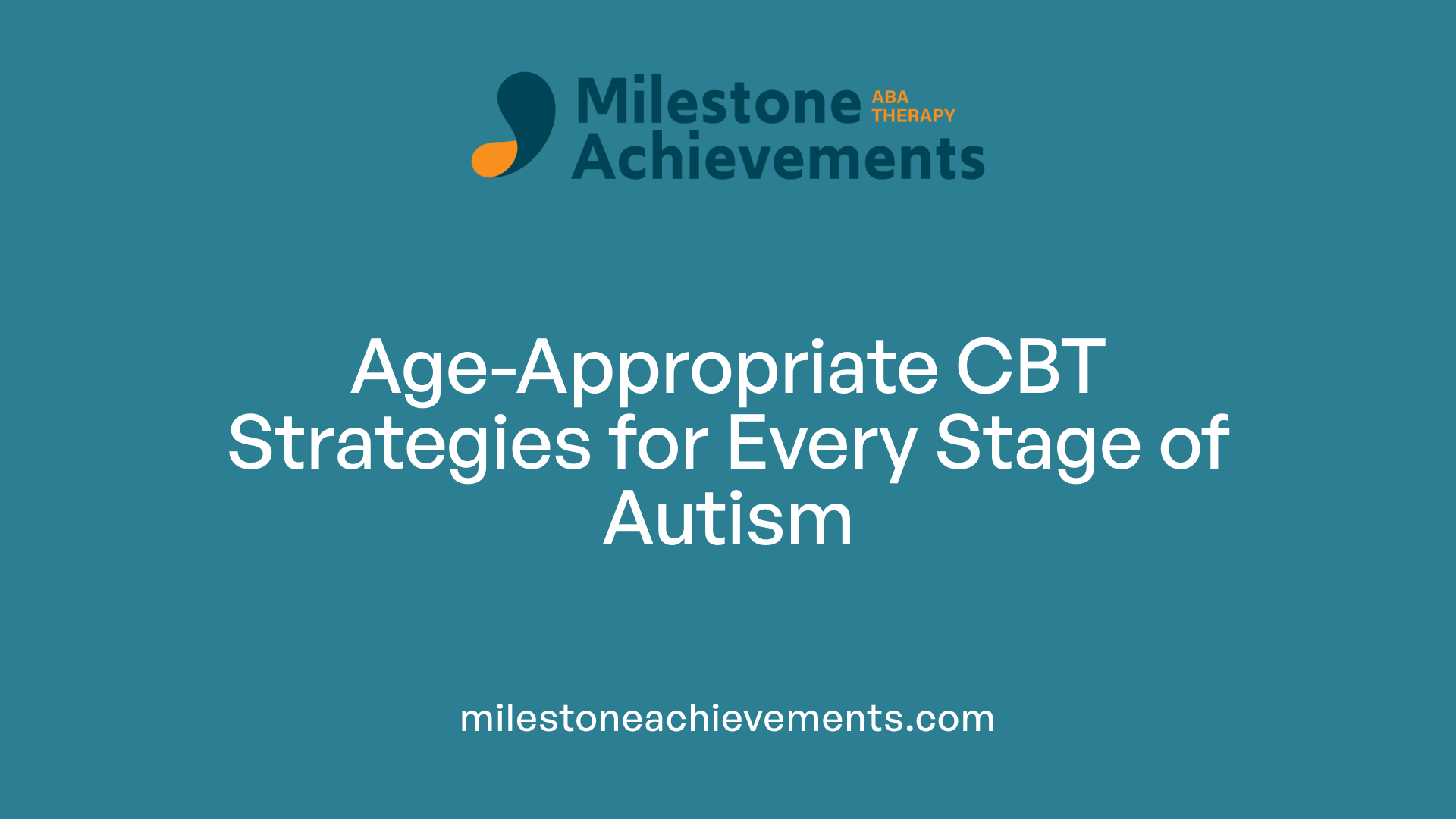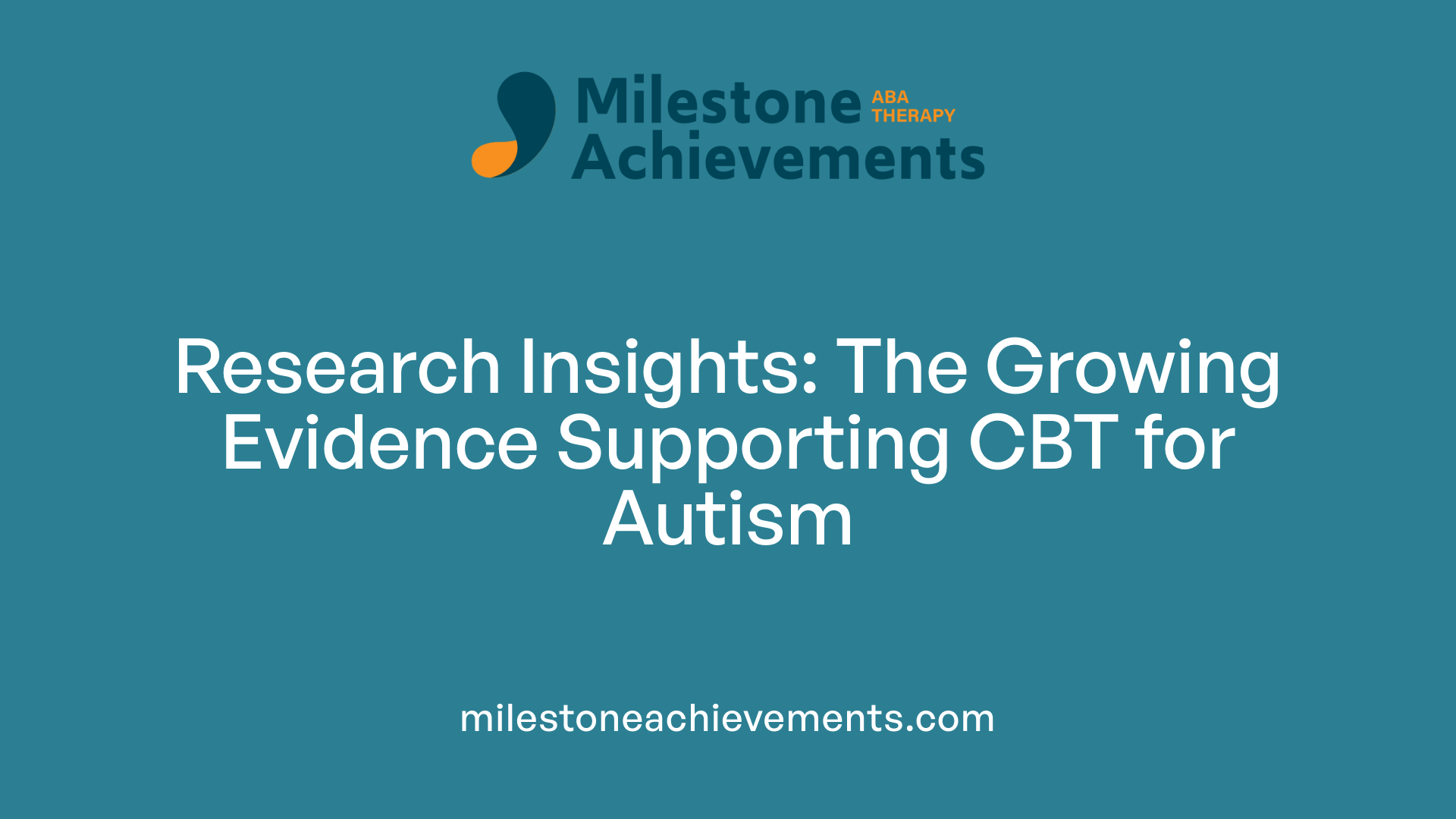
Cognitive Behavioral Therapy for Autism
Advancing Emotional and Social Skills in Autism Through CBT
Understanding the Role of CBT in Autism Treatment
Cognitive Behavioral Therapy (CBT) has gained recognition as an effective, evidence-based approach to addressing various emotional, behavioral, and social challenges associated with Autism Spectrum Disorder (ASD). Focusing on the interplay between thoughts, feelings, and behaviors, CBT is tailored to meet the unique needs of autistic individuals across different age groups, empowering them with skills to manage stress, anxiety, social interactions, and co-occurring mental health issues. This article explores how CBT works for autism, how it is adapted for different ages, its scientific backing, and practical guidance for accessing this therapy.
What is Cognitive Behavioral Therapy (CBT) and How Does It Work for Autism?

What is Cognitive Behavioral Therapy (CBT) and how does it work for autism?
Cognitive Behavioral Therapy (CBT) is a structured, goal-focused form of psychotherapy that centers on understanding the links between thoughts, feelings, and behaviors. It is based on the premise that unhelpful or negative thoughts contribute to emotional distress and problematic behaviors. By learning to identify and challenge these thoughts, individuals can develop healthier coping strategies.
When applied to autism spectrum disorder (ASD), CBT is often adapted to meet the unique needs of each person. Since many individuals with autism process information in a concrete and visual manner, therapists incorporate methods like visual supports, repetition, and engaging activities that align with their learning style. For children, teens, and even adults with ASD, CBT aims to address common challenges such as anxiety, social difficulties, and emotional regulation.
How does CBT target thoughts, feelings, and behaviors in ASD?
CBT helps individuals with autism recognize automatic negative thoughts that may lead to heightened anxiety, frustration, or social withdrawal. The therapy involves teaching clients to observe their internal thoughts and feelings and understand how these influence their actions.
A typical session might include activities such as identifying unhelpful beliefs, learning relaxation techniques, or practicing social skills through role-play. An essential aspect is understanding and modifying patterns like 'black-and-white' thinking or overgeneralization, which are common in ASD. By systematically addressing these thought patterns, individuals can respond more adaptively and reduce emotional distress.
Collaborative approach involving therapists, individuals, and families
CBT is not delivered in isolation but rather through a collaborative effort involving trained therapists, the individual with autism, and often their family members or caregivers. For children, family involvement is crucial — parents learn strategies to support their child's emotional well-being and reinforce skills outside of therapy.
Therapists work together with families to set specific, achievable goals and to tailor interventions that align with the person’s strengths and challenges. This teamwork ensures that skills learned in sessions are generalized across various settings like home and school.
Techniques like identifying negative thoughts, developing coping skills
Key techniques in CBT for ASD include:
- Identifying Negative or Unhelpful Thoughts: Recognizing automatic thoughts linked to anxiety or low mood.
- Challenging and Reframing Thoughts: Learning how to question the validity of these thoughts and replace them with more realistic or positive ones.
- Developing Coping Strategies: Such as relaxation exercises, mindfulness, and problem-solving skills that help manage stress.
- Exposure to Anxiety-provoking Situations: Gradual exposure combined with coping skills helps reduce avoidance behaviors.
- Role-playing Social Interactions: Practicing social skills in a safe environment to increase confidence.
Evidence supporting CBT in autism
Research consistently indicates that CBT is effective in improving social skills, reducing anxiety, and helping manage emotional regulation in children and adolescents with ASD. Systematic reviews and meta-analyses reveal that many individuals respond positively, especially when interventions are personalized and adapted to their sensory and cognitive needs.
In conclusion, CBT offers a practical, evidence-based approach that empowers individuals with autism to navigate their world more effectively. It helps modify unhelpful beliefs, develop emotional resilience, and improve social functioning, making it a valuable component of comprehensive autism support.
Adapting CBT for Different Age Groups with Autism

How is CBT adapted for individuals with autism across different age groups?
Cognitive Behavioral Therapy (CBT) tailored for individuals with autism spectrum disorder (ASD) varies significantly across age groups, ensuring that therapy remains engaging, understandable, and effective. For children, therapists often incorporate visual supports such as picture schedules, emotion faces, and social stories to help young clients grasp abstract concepts like feelings and thoughts.
Family involvement is a crucial element in child-focused adaptations. Parents and caregivers actively participate in therapy sessions or receive coaching to reinforce skills at home. Strategies are often interests-based, utilizing children’s favorite topics or toys to motivate participation. The activities emphasize repetition, concrete instructions, and clear expectations to match their developmental level, making learning accessible and engaging.
As children grow into adolescence and adulthood, modifications focus on fostering stronger therapeutic alliances and developing emotional literacy. Therapists build rapport through empathetic communication, using role-playing exercises that simulate real-life social situations. They also introduce sensory considerations and accommodate individual preferences, such as using visual aids, timers, or written materials, to support emotional regulation and social skills.
Across all ages, personalized goals are central. Therapists assess each person's strengths, challenges, and interests to tailor tools and strategies. For example, someone who is highly visual might prefer diagrammatic thought records, while another may benefit from mindfulness or relaxation techniques adapted for sensory sensitivities.
Training practitioners in ASD-specific adaptations is essential for success. This involves specialized education in autism-friendly communication, sensory needs, and behavioral flexibility. Supervision and ongoing professional development ensure therapists can confidently implement these adaptations, making CBT a flexible and responsive intervention.
In summary, challenges and developmental needs influence how CBT is approached across age groups. Children benefit from visual, interest-based, and family-integrated methods, while teens and adults focus on building rapport, emotional awareness, and sensory accommodations. Personalized therapy plans and well-trained practitioners are vital for optimizing outcomes for individuals with autism at every life stage.
| Age Group | Adaptation Strategies | Key Tools & Techniques | Goals Focus |
|---|---|---|---|
| Children | Visual aids, interests, family involvement | Social stories, picture schedules, concrete instructions | Emotional recognition, social skills, anxiety reduction |
| Teens | Role-play, emotional literacy, sensory supports | Visual prompts, mindfulness, social scripts | Self-awareness, independence, social interaction |
| Adults | Rapport-building, role-play, sensory sensitivity | Visual supports, relaxation techniques, personalized plans | Emotional regulation, social functioning, coping skills |
Understanding and implementing age-appropriate modifications make CBT more accessible and effective for autistic individuals, supporting their emotional growth and social integration at every stage of life.
Benefits and Evidence Supporting CBT in Autism Spectrum Disorder

What are the benefits and effectiveness of CBT for autism spectrum disorder?
Cognitive Behavioral Therapy (CBT) provides multiple benefits for individuals with autism spectrum disorder (ASD), particularly in managing secondary emotional and mental health challenges. Research indicates that CBT is effective in addressing issues such as anxiety, depression, and social difficulties commonly experienced by these individuals.
One of the primary advantages of CBT is its ability to help individuals recognize and modify unhelpful thoughts and maladaptive behaviors. For example, children and adolescents with ASD often struggle with anxiety, which can interfere with daily functioning and social participation. Adapted forms of CBT focus on reducing anxiety symptoms, helping individuals to confront fears gradually and develop coping skills.
Besides anxiety reduction, CBT is also shown to improve social skills and emotional regulation. Many individuals with ASD have difficulty interpreting social cues and recognizing emotions, which hampers their ability to form and maintain relationships. Through structured and individualized sessions, CBT teaches techniques like emotion recognition, social problem-solving, and self-acceptance.
Research through systematic reviews and meta-analyses underscores the positive role of CBT. A comprehensive analysis of 45 randomized controlled trials (RCTs) involving nearly 2,500 children and adolescents with ASD found that CBT significantly improved autism-related symptoms and social skills based on several measures, including observer and clinician ratings. Although self-reported outcomes showed less consistent results, informant-based assessments highlighted meaningful improvements.
The effect size observed in studies indicates a moderate but clinically relevant benefit, with many individuals experiencing enhanced quality of life, reduced anxiety, and better social interactions. Notably, the evidence supports the use of CBT not only for children and adolescents but also for some adult populations, especially those with high-functioning autism who can engage in cognitive and behavioral strategies.
In summary, CBT is a well-supported intervention with demonstrated benefits in reducing anxiety and depression, improving social skills, and enhancing emotional regulation. Its structured, therapy-based approach is adaptable and has shown promising results across various age groups, making it a pivotal component in autism-related behavioral therapies.
Scientific Evidence and Research on CBT for Autism

What scientific evidence supports CBT as a treatment for autism?
Research on Cognitive Behavioral Therapy (CBT) for autism spectrum disorder (ASD) indicates a growing body of evidence that suggests it can be effective in managing certain symptoms and co-occurring conditions. Several randomized controlled trials (RCTs) and meta-analyses have contributed to understanding its impact.
Among these, a notable systematic review included 45 RCTs involving 2,485 children and adolescents with ASD. The findings showed that while CBT did not significantly reduce core autism symptoms based solely on self-reports, it did produce notable improvements when assessments were provided by clinicians, informants like parents and teachers, and through task-based evaluations. These results point to CBT’s potential in alleviating associated issues rather than directly modifying the core aspects of autism.
In particular, the evidence supports benefits in reducing secondary conditions such as anxiety, obsessive-compulsive disorder (OCD), and social-emotional challenges. For example, adaptations of CBT have demonstrated substantial success in decreasing anxiety levels in autistic children, with about 70% responding positively in various studies. These adaptations often include visual supports, structured approaches, and involvement of caregivers, which help meet the unique learning and processing styles of autistic individuals.
Further, meta-analyses examining multiple studies have shown that CBT can improve social communication and emotional regulation — key areas that impact quality of life. A 2016 study by Weston et al. highlighted that roughly 78% of children with autism experienced improvements after around three months of structured CBT sessions.
However, despite these promising results, the research quality varies. Many studies face limitations such as small sample sizes, heterogeneity in participant profiles, and differences in the therapeutic protocols used. The overall evidence indicates that while CBT shows significant promise, especially for managing anxiety and related emotional difficulties, more high-quality research is needed. This research should focus on refining techniques, ensuring accessibility, and establishing long-term outcomes.
In summary, the scientific literature provides a supportive but cautious outlook on CBT’s role in autism treatment. Its main strengths lie in alleviating comorbid anxiety and enhancing social skills, with ongoing research needed to fully understand its scope and maximize its benefits for diverse autistic populations.
Specific Modifications and Techniques in CBT for Autism
How is CBT modified or adapted specifically for autistic individuals?
Cognitive Behavioral Therapy (CBT) has proven beneficial for many individuals on the autism spectrum, but adaptations are often necessary to meet their unique needs. These modifications focus on making the therapy more concrete, visual, and experiential, aligning with typical cognitive strengths and challenges faced by autistic people.
One common approach is the extensive use of visual aids, such as picture schedules, social stories, and visual supports. These help clarify abstract concepts like social rules or emotional responses, making them easier to grasp.
Role-playing activities are also integral. Clients practice social situations or emotional reactions in controlled, supportive environments, which can boost confidence and understanding.
Repetition and routine are emphasized within sessions. Consistent reinforcement of strategies helps in retaining skills and building routine-based habits.
Therapists tend to use concrete language, avoiding metaphors or abstract statements that might be confusing. Instead, clear and direct language ensures better comprehension.
Involving family members and caregivers is another crucial adaptation. Teaching parents and guardians specific strategies allows reinforcement of skills at home and in daily life.
Sensory sensitivities are carefully considered during therapy. Clients might have preferences or aversions to certain stimuli, so therapists tailor activities to accommodate these sensitivities.
Additionally, therapy often incorporates special interests of the individual—such as favorite topics or hobbies—to motivate engagement and facilitate learning.
Practitioners trained in ASD adaptations focus on building skills through multimodal methods, including visual, auditory, and tactile activities, to cater to different learning styles.
Training programs for therapists emphasize understanding autism’s core traits, equipping them with strategies to make CBT accessible and effective.
These tailored modifications aim to reduce anxiety, improve social and emotional understanding, and foster independence. The evidence indicates that such adaptations significantly increase the effectiveness of CBT for individuals on the autism spectrum, supporting their mental health and social functioning.
| Modification Method | Description | Impact |
|---|---|---|
| Use of visual aids | Pictures, charts, social stories | Enhances understanding of social cues and emotions |
| Role play | Practicing real-life scenarios | Builds confidence and real-world skills |
| Repetition | Regular practice of core skills | Reinforces learning and retention |
| Concrete language | Clear, literal instructions | Reduces confusion and increases clarity |
| Family involvement | Training caregivers | Supports generalization outside therapy |
| Sensory considerations | Tailored activities | Prevents overload and maintains engagement |
| Incorporation of interests | Custom topics or hobbies | Motivates participation and learning |
In sum, these modifications make CBT more accessible for autistic individuals, helping them effectively develop skills to manage anxiety, improve social interaction, and foster emotional resilience.
Goals and Outcomes of CBT in Managing Autism and Co-occurring Conditions
What are the goals and expected outcomes of using CBT to manage autism symptoms and co-occurring conditions?
Cognitive Behavioral Therapy (CBT) is a structured approach that focuses on helping individuals with autism develop better emotional and social skills. One of the primary goals of CBT is to reduce common co-occurring mental health issues such as anxiety, depression, and stress. Many children and adolescents with autism experience heightened anxiety, which can interfere with daily functioning. CBT aims to teach coping skills, such as relaxation techniques and gradual exposure, to manage these feelings effectively.
Enhancing social communication and social skills is another vital aspect of CBT for autism. The therapy helps individuals recognize social cues, understand others’ emotions, and respond appropriately. These skills are essential for building relationships, participating in social activities, and increasing independence. CBT often incorporates role-playing and social scenarios to practice these skills in a safe environment.
Promoting self-acceptance and resilience is a core outcome of CBT. As individuals learn to challenge negative thoughts about themselves—such as feelings of inadequacy or social rejection—they develop healthier self-perceptions. This fosters resilience, helping them better cope with social setbacks or sensory challenges typical in autism.
Tailoring goals to individual needs ensures that CBT remains relevant and effective. Therapists work with individuals and their families to set personalized objectives based on their unique strengths, weaknesses, and life circumstances. For example, a child with social anxiety may work on initiating conversations, while another might focus on managing anger or improving emotional regulation.
Expected improvements from CBT include increased emotional regulation, better social functioning, and more positive behaviors. Many individuals show a noticeable decrease in anxiety levels, leading to fewer escape behaviors and a greater ability to participate in everyday activities. Additionally, improvements in social skills often translate into better peer relationships and academic engagement.
While CBT does not cure autism itself, it provides crucial tools for managing secondary issues that impact quality of life. Its structured, problem-focused nature equips individuals with lifelong skills to handle emotional and social challenges more effectively, fostering independence and overall well-being.
Empowering Autistic Individuals through Evidence-Based Therapy
Cognitive Behavioral Therapy stands out as a versatile, effective intervention tailored to improve the emotional and social well-being of individuals on the autism spectrum. Its structured yet adaptable nature allows therapists to meet diverse needs across different age groups and cognitive levels. Supported by a growing body of research, especially its efficacy in reducing anxiety and enhancing social skills, CBT offers hope and practical tools for many autistic individuals. Accessing qualified practitioners and utilizing tailored modifications can significantly enhance therapy success. As ongoing research refines CBT protocols, its role in comprehensive autism treatment continues to grow, promising better quality of life and independence for those on the spectrum.
References
- Cognitive Behavior Therapy for Autism | NICHD
- Cognitive Behavioral Therapy for Autism Spectrum Disorder in ...
- Cognitive Behavioral Therapy (CBT) - Autism Speaks
- Cognitive behavioural therapy to improve social skills in children ...
- Cognitive Behavioral Therapy and Autism Spectrum Disorders
- Cognitive Behavioral Therapy for Autism Spectrum Disorders
- Cognitive behaviour therapy (CBT) interventions - Autism CRC


Partner with us on your child's journey
Milestone Achievements offers evidence-based ABA therapy to help children with autism reach their full potential. Together we’ll set meaningful goals and celebrate progress every step of the way.
Start ABA Services Today





